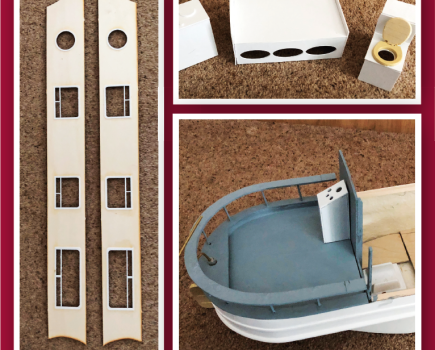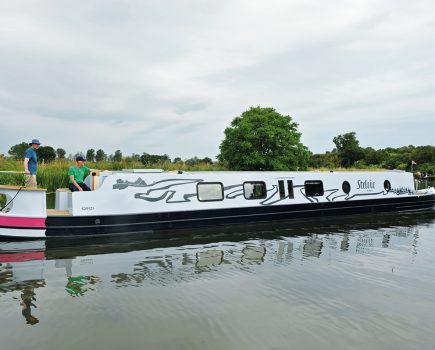The owners of Baleine, Susan Brown and Toby Whale, found that an extra 4ft has radically improved their boat

What difference does an extra 4ft make? If you’re following in the tracks of a former editor of this magazine and cycling from Land’s End to John O’Groats, then the answer is probably not much. But if you’re trying to take an old sideboard to the tip in a small hatchback, the answer is probably quite a lot. In boating terms, adding 4ft to the length of a boat may not seem like a big deal. But the owners of Baleine, Susan Brown and Toby Whale, would argue that it has radically improved their boat.
We first reviewed Baleine back in 2012; then during lockdown, when it wasn’t possible to carry out boat tests, we included it in our look back at some of the notable boat interiors we’d seen over the past few years. That prompted Toby to get in touch, to say that the boat had recently been stretched. They’d had 4ft inserted into the forward part of the boat.

Making your boat longer involves a lot of work
Having a boat stretched is quite a decision, partly because there’s a lot of work involved, and partly, as Toby says, because the object you most love in the world needs to be cut in two to make it happen. It’s not just a matter of making a cut and adding some extra steel. Electrics and water pipes almost certainly run down the length of the boat, and there might be gas pipes too, all of which need to be dealt with. And you can’t cut the steel without first removing a section of fitout because gas cutting and welding could set fire to woodwork. The fitout then needs to be reinstalled, extended, and matched.
Susan and Toby chose Martin Kedian to do the steelwork. He’s well known for this sort of thing — not just stretches but turning windows into side hatches and installing Houdinis in roofs, for example. They had decided that Baleine would benefit from extra length in the dinette and saloon. There would be an extra porthole one side, and an extra side hatch the other. Martin suggested that while they were having the cut done, they might as well add 6ft rather than four — but the couple had reasons for sticking to their original choice: the boat was going from 58ft to 62ft, which meant that the Leeds and Liverpool Canal would still be passable (any longer, and it wouldn’t be); and they were conscious that every extra foot would add weight and possibly affect handling.
Baleine was taken out of the water and transported to Martin’s workshop in Stockton in Warwickshire, close to the Grand Union Canal. Once a section of fitout is removed and all the services cut, temporary bracing is put in to support the shell to make sure it doesn’t go out of shape. Then the cut can take place, and extra panels welded into the gap. The welds need to be carefully done so they’re not visible on the outside, while inside the bracing which keeps the hull and cabin sides rigid has to be replicated. To make sure everything looked just right. Martin even travelled up to the Tyler Wilson yard in Sheffield to collect matching rivets to go below the gunwales. The new hull is blacked, and the new steel in the cabin sides and roof is returned in red oxide primer.
The new section then needs to be fitted out — and it needs to match. Susan and Toby took the boat back to Jim Birch, who fitted it out originally. He used a lot of reclaimed timber in his fitout (recycling wood is his speciality) and was able to find some more wood from the same Northamptonshire hall used in the original fitout, so it would match exactly on the cabin sides. There was none of the wood originally used on the floor left, so a different wood had to be used — but you would never know. The boat has a keelson — a plank running down the centre of the boat, with planks coming off it at right angles — and Jim was able to replicate the original look.
Extending the dinette was one of the main changes possible because of the stretch, so Jim completely rebuilt this area. He also rebuilt an under-gunwale TV unit which he claimed never to have been entirely happy with, believing the pine used needed to be a different shade.
On the outside, it’s very difficult to match old and new paint because of the effects of fading. Toby says the boat needed a repaint anyway, so they had the whole boat taken back to bare metal and repainted to look exactly the same as before. The work was done by Steve Furniss, who’s based at the same yard at Weedon on the Grand Union as Jim.
The stretch made a huge difference
So to return to the original question, what difference has an extra four feet made? The additional length was towards the front of the boat, which Toby says lost out in the original plan: they’d started with the cabin, shower room, tiny office area and galley — and the dinette and saloon had been assigned whatever space was left. It meant that the dinette had been rather short, at just 4ft. It consisted of a pew-like bench across the boat with a short return. Converting it into a guest bed meant a series of extensions had to be added. The new dinette is a more conventional 6ft L-shape design, which both offers more space day to day, and also converts into a guest bed much more easily. It also has an opening side hatch above, and (Susan’s favourite feature) there’s an additional under-floor larder alongside. This space, with a lift up hatch in the floor, makes use of the gap between the floor and the baseplate, which is naturally cool because it’s under water. It’s ideal for storing things such as veg, which need to be cool but don’t necessarily have to go into the fridge.
With two of the four feet accounted for in the dinette, the remaining two feet make for a more spacious saloon. Toby says the changes have made a big difference. “It sounds stupid,” he says, “but the extra space has turned Baleine from a great holiday boat into a serious liveaboard”. Not only has it given the couple more room to spread out, but the extra roof length has also been put to work, with extra solar panels. The boat now has a solar array of 600 watts, giving a real boost to the battery charging regime, and meaning the couple don’t have to run the engine so often.
There is, though, one area where the extra length has made no difference at all — and that’s in the handling. Baleine is built on a Tyler Wilson shell, which are some of the best handling boats around. Toby says that steering it feels exactly the same. It still swims perfectly, and turns in the same way. It’s just that when entering a lock, you have to remember to stop slightly sooner.
Of course any work on a boat costs money, and this was significant work. Martin Kedian says on his website that a stretch costs around £975 per foot — but of course it depends on exactly what you’re having. This stretch included a side hatch and a porthole, which are clearly more complicated than a plain sheet of steel (and they had the tiller lowered a little). Don’t forget too that the cost of lifting and transporting the boat also needs to be factored in. Refitting the inside also costs, and again the amount depends on what’s done. Simple panelling could be inexpensive, but in this boat not only was the wood reclaimed, there were other changes such as the re-configuring of the dinette. The paintwork was also a significant amount of money (a complete one always is) but it’s something they would have had done sooner or later anyway.
Not everyone will agree that it was worth spending what adds up to a significant amount of money on an extra 4ft of boat; but Susan and Toby are convinced it was good value for their money. The alternative would have been having a new, longer boat built, or trying to find one that suited their needs — both options which could also have been costly and taken longer. The couple say they’ve ended up with the best of both worlds: they still have everything they always loved about their boat, but with improvements. For them, an extra 4ft has made all the difference.
Image(s) provided by:
Archant







